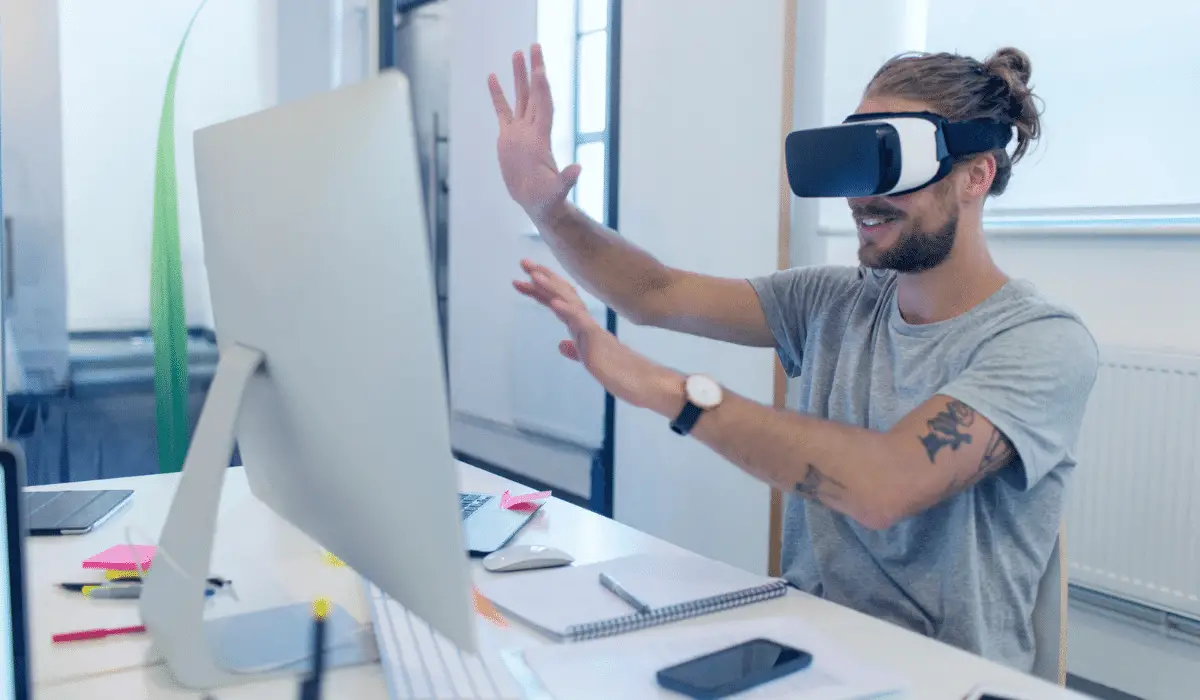Statistics show that the global AR and VR market will likely grow to $209.2 billion by 2022. Moreover, VR market projections show that worldwide spending on AR/VR will reach $72.8 billion by 2024.
Thus, it’s apparent that VR has been growing exponentially in the past few years. Let’s check out the state of the VR world before, during, and after the pandemic:
Why Is VR Popular?
According to research, 78% of Americans are familiar with virtual reality technology. Technology can potentially influence the way we socialize and work.
VR is an immersive technology; its application includes wearing a headset that promotes a 360-degree simulation. Let’s discuss why VR is popular and transforming the business dynamics:
1. Increases Automation VR and AI Enhancements
VR combined with AI can potentially change the world. Today, developers integrate AI within VR technologies to automate our everyday processes.
2. Augments the Ease of Learning Complex Things
Our efficiency of education increases whenever we learn something by listening to and doing it. VR offers us the opportunity to learn complex things efficiently and in less time.
See Also: The Role of Technology in Business Growth
How Can VR Affect Your Life?
Virtual Reality continues to grow in popularity as many people seek a truly immersive gaming experience. But users of VR games report experiencing troubling effects such as damage to their vision, seizures, and disorientation.
In addition, using VR and immersing yourself in a virtualization world comes with a risk of injury, including broken bones, torn ligaments, and electric shocks.
But it’s not all dark and gloomy! VR has the potential of changing the education, businesses, and medical world:
- Education: VR teachers can use puzzles and games to help students learn in a more engaging environment
- Business: VR allows you to breathe life into your business ideas and procedures by allowing customers and employees to feel like they’re with you
- Medical: VR enables doctors and nurses to view and practice surgeries, patient engagement, and new machines
- Mental Health: VR helps treat anxiety, PTSD, and addictions by assisting patients in mediating, learning cognitively, and more
See Also: 5 Educational Technology Trends
How Was VR Before Pandemic?
In 2014, Oculus’s founder predicted that VR would take the market by storm. Fast forward to today, VR is yet to change the world.
In fact, an insightful survey by Greenlight Ventures reveals that only 28% of VR headset owners use their devices daily. The rest of the time, their headsets are collecting dust.
How Was VR During Pandemic?
During the Covid-19 pandemic, extended lockdowns prompted the adoption of virtual reality. According to research, global spending on AR and VR reached $12 billion in 2020 from 2019 (an increase of 50%).
Another study reveals that one in five buyers in the U.S. started using VR in 2020.
You May Like: 10 Benefits of the Cloud-Based eLearning
Is VR Finally Taking Off?
The VR world continues to grow post-pandemic so much that the VR market will likely reach $2095 billion by 2027, experiencing growth at a rate of 68.5%. Today, the VR world has evolved from a niche technology to an accelerating trend.
As of now, there are more than 171 million VR users globally. From Oculus Rift to Google Daydream, it’s apparent that VR is getting hype.
Unfortunately, 77% of VR users want more social engagement in their headsets. Users believe that while Oculus Rift, PS, and Google Daydream offer you an immersive experience, it doesn’t live up to their expectations of lifelike digital interactions.
But that doesn’t mean you can’t enjoy escapism on VR or expect a fully immersive experience soon.
Let’s discuss further why we shouldn’t give up on VR yet.
1. Benefits of VR in Education
Teachers globally are leveraging VR to enhance student engagement rates by creating products in the natural world around them.
Virtual Reality redefines education, allowing teachers to take their classrooms on virtual field trips worldwide. It also enables students to explore art galleries and museums.
In addition, VR offers the following benefits to learners:
- Increases knowledge area
- Eliminates potential distractions while studying
- Boosts student creativity by employing existing game-based education models
- Improve the understanding level of students as it is suitable for different learning styles
See Also: Machine Learning (ML): What’s in Store in the Future?
2. Benefits of VR in Education
It’s no secret that learning by doing is a far more efficient way of retaining information and learning new skills. The efficiency of VR depends on its potential for creating realistic spaces where learners can gain active, hands-on experience.
Moreover, VR training enables businesses to benefit from the following features:
- Address Process Skills: Gamification of work processes allows employees to problem solve, work harder, and increase productivity
- Learn Soft Skills: VR improves customers’ soft skills by eliminating potential awkwardness and discomfort employees face when delivering speeches or presentation
- Reduces Costs: VR technology helps businesses save time and money while collaborating in real-time through innovative tech.
You May Like: How 5G Will Change the Smartphone Experience?
Conclusion
Virtual Reality’s advanced, immersive capabilities encourage users to collaborate and connect. Professionals agree that virtual scenarios can help treat social anxiety and PTSD. Moreover, VR provides consumers with the solutions they need, particularly since it has the potential to transform the future of learning and development.
Felix is the co-founder of GrowthBoost, an online journal covering the
latest software and marketing tips for entrepreneurs. Alongside digital
journalism, Felix recently graduated from university with a finance
degree and enjoys helping students and other young founders grow their
projects.





















